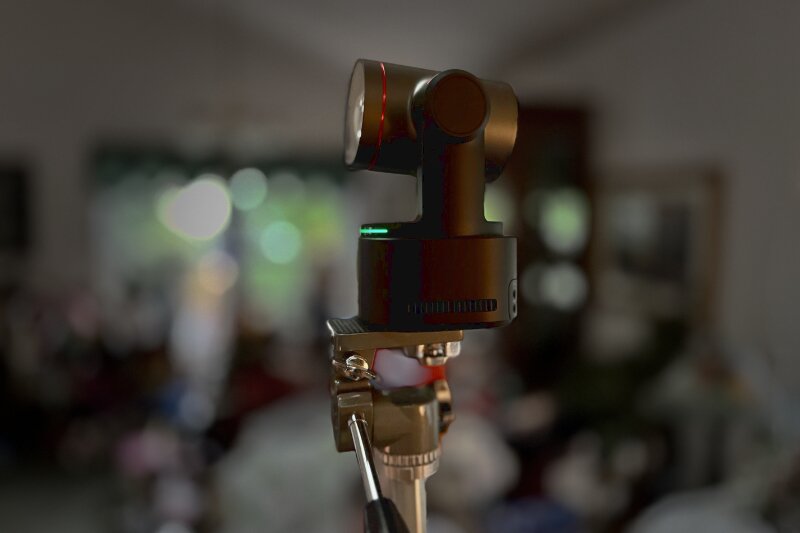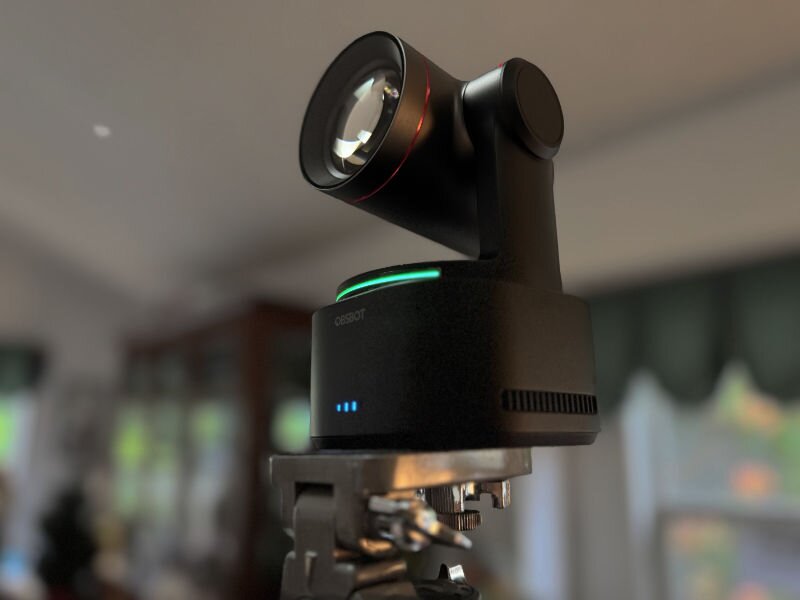
I’ve reviewed a lot of technology over the years, always aiming to use it as intended. In the case of the OBSBot Tail 2, life had other ideas. What do you do with an action-ready, live streaming camera when you can barely move?
OBSBot gave me the opportunity to get prerelease access to the Tail 2 for real-world testing and feedback in my church’s ministry efforts. They were gathering interesting use cases and accompanying videos to show off their new, souped-up camera and my church’s needs fit the sort of situations they wanted to explore.
As a “hybrid church,” emphasizing both the in-person and online, we had a veritable gamut to throw at the Tail 2. Live streaming of in-person services, video devotionals recorded in different locales and weekday “in studio” live streams are all part of a normal week at the church. I was excited to put this new camera through its paces and share feedback.
I didn’t get to do that. Just days after the Tail 2 arrived, a series of unfortunate encounters with snow, ice and shovels put me out of commission. A serious, long-lasting back injury left me stuck lying down for most of 2025. I can stand for limited times, but I’m certainly not hiking trails or doing almost any of the interesting things OBSBot and I had hoped to explore with this camera.
The Tail 2 is the successor to the Tail Air, a competent streaming camera that features a moving head (“pan-tilt-zoom” or “PTZ”) for tracking action or reframing scenes without requiring manual camera movement. Both offer wireless control from your phone or computer along with the ability to stream straight from the camera to the internet. The Tail 2’s differences from its predecessor read like a veritable wishlist: a built-in Ethernet port for if you want a wired connection, SDI for professional video workflows, larger optics, a full optical zoom and a notably larger, longer lasting battery.
A highlight for the planned testing was its built-in gimbal functionality, which enables the Tail 2 to stabilize itself and fight off bumpiness in action videos. That’s perfect for moving about, which is precisely what I have not been doing.
Ministry didn’t stop because of my injury, of course, so I found myself woodenly standing in front of a camera to record bits during my brief times standing upright. As I did so, I started using the Tail 2 to film those videos so I could at least offer some feedback, even if not what had been intended.
No fancy networked Ethernet connections or SDI came into play. No moving about on a stage to test its ability to use AI to track a subject. And, especially, no taking it on action-packed adventures in need of stabilization. I felt like I was wasting the camera’s potential.
Then it struck me: there’s something remarkable about this camera you won’t see in reviews tackling its penchant for action.
If you find yourself temporarily incapacitated, like I have been, or simply don’t do action filming, is there any use for a camera packed with features to support what you aren’t going to do? Yes.
What felt like a wasted opportunity with a feature-packed camera has turned out to be a blessing. As days rolled into weeks and I realized a quick fix wasn’t in the offing, I wondered how I would resume some of the filming that was a regular part of my ministry. Time to think creatively.
I regularly run a mess of cables to create high quality live streaming setups in different places. How was I going to get back into gear when all the motions of rolling out cabling for cameras, wiring all kinds of audio equipment, controlling everything, bending over, adjusting tripods — all of that was off the table for me? I could do some of it briefly, but I’d pay a cost if I did: slowing or even reversing recovery.
Determined to avoid flaring up my injury, the Tail 2 came unexpectedly to the rescue. Having a camera that you can adjust without actually having to move around a lot is just what the doctor ordered. Literally.
Eschewing the big setup, I went for a simple, light tripod and the Tail 2. I can awkwardly unlock the tripod legs and let gravity pull them to the ground I’m ill-advised to bend over to reach, put the camera on it and be good to go. I fuss with tripods a lot, bending over to turn knobs and adjust the tripod just so. With OBSBot’s software, I can fix myself in the position I need to be in for recording, go into the app, hit the camera button, and tweak the camera’s position without having to move my position.

The “OBSBot Start” app interface is central to using the Tail 2. It looks a lot like other camera interfaces on a smartphone. It worked great for me on the iPhone and even better on the more spacious screen of an iPad.
OBSBot’s app was almost certainly inspired by another live streaming camera, the Mevo, and that company’s pioneering work on the “smartphone controlled streaming camera” genre they created a decade ago. If you’ve never used a Mevo, such as the Start we reviewed a few years back, just think “smartphone camera interface” and you get close enough. It’s straightforward.
OBSBot’s interface may ape that of Mevo, but the Tail 2 — and their other cameras — are not Mevo clones. While the Start is an excellent, affordable live streaming camera option, OBSBot’s offerings are set apart by that motorized PTZ functionality. The first Mevo cameras tried to do “simulated PTZ,” but the simulation was only somewhat successful and the company ultimately abandoned the initiative on cameras like the Start.
That gives OBSBot room to add its unique spin with cameras that actually can spin themselves. The Tail 2’s ability to pan, tilt, zoom and even rotate (PTZR) significantly expands what is possible to do in a remote control app. If the tripod is slightly crooked, I don’t have to struggle with it, I just tweak the camera’s position from the app. The camera — and not injured me — does the physical movement.
I typically use a mirrorless camera when “in studio,” but unlike a MILC or SLR, both of which typically require an HDMI input card on the computer and an HDMI cable between the camera and computer, the Tail 2 has been a back-saver by sending the video to my computer wirelessly via NDI.
If you do live streaming, or anything related, you are likely already familiar with NDI (or should be). I can turn it on to that mode and have the camera’s video go straight into OBS Studio (which, despite the name, is not made by OBSBot) on my computer wirelessly over my relatively average mesh Wi-Fi 6 network. The video version of this review was recorded using that exact setup. The only wire I had to run was for a microphone.
Speaking of microphones, the absence of one on the Tail 2 is perhaps the biggest con to its design. For a camera capable of being taken into the action, it feels like an odd omission, especially since the previous generation Tail Air, which is still available and is cheaper, did include one.
In fairness, very few camera microphones are decent enough for serious recording. If a feature had to be dropped to keep the price in check, it’s a reasonable one to chop. Users can connect a microphone directly to the Tail and mount both onto a small rig for handheld use or simply have a microphone nearby going straight to the computer (as I have done) for stationary setups. But, it’d be nice to have even a mediocre built-in mic “just in case.”
While I’ll leave it to the uninjured YouTubers of the world, who have been taking the Tail 2 on adventures since its release, to explore all the camera can do, it’s been fantastic for my situation. It’s so easy to get it exactly where you want it and when every bit of physical exertion has a steep “cost,” if it can be done at all, I’ve suddenly come to appreciate how beneficial that is.
Beyond wiring it up, when I use my mirrorless camera, I’ve gotten up from my desk more times than I can count to fiddle with the dials a bit. Back in the good old days I could sit down in a chair, I’d be in my studio’s chair, get up, walk over to the camera, adjust settings, go back, sit down, realize it’s not quite right, get up again. Rinse and repeat.
None of that is necessary with the Tail 2. And, with a good, live video feed in the app, some sort of confidence monitor setup — or squinting at a camera’s tiny screen (if it is the sort that can be swiveled to the front) — is unnecessary for solo piloted filming.
None of this is to imply the camera is less useful when able-bodied. If you want to live stream events, for example, a PTZ camera is an incredible tool. We use several of varying brands, including OBSBot, at my church. Both OBSBot’s wired and wireless cameras’ PTZ functionality can be controlled in a single app on Mac or Windows, which is great if you want to do a multi-cam setup and rapidly adjust the cameras as you do.
If you’re not overseeing a large venue with camera operators, and you need one person to control everything from a live streaming computer, having PTZ cameras is a game changer. They help capture just the right moment. In live events, I’ve learned you’ll never have enough cameras to get every angle you might want, so being able to change camera positions is mighty useful. For multi-cam setups, the Tail 2 includes a “tally light” compatible with software such as OBS Studio that indicates when the camera is the “live” source being streamed or recorded.
OBSBot’s cameras have good color, and lots of adjustments for exposure and white balance. As with every camera, years behind the manual controls of a DSLR have made me too much of a control freak to let the camera decide how things should be adjusted. I like to pick my own white balance and adjust exposure to get the look I want. The defaults are of average competence, though, if you prefer to avoid fiddling.
I didn’t make things easy on the Tail 2 as far as color balance goes: trying to avoid moving around equipment with my back, as I mentioned earlier, I set up “light.” It was just me, the camera, a tripod and a microphone. Normally, I’d use two or three LED light panels with good CRI ratings to create an environment conducive to accurate color reproduction. Not this time — I depended on the daylight from a couple of skylights alongside table lamps with warm-colored bulbs. This is very far from “ideal,” so it is all the more laudable that the results featured reasonably acceptable color.
AI tracking works fine enough, too, though my less-than-action-packed present level of movement limited my testing. I can say from experience with multiple other OBSBot cameras in more spry times that the company’s systems do what they promise. That said, I hesitate using tracking in most situations for aesthetic reasons. I don’t always like the framing it chooses — it isn’t wrong, but it often isn’t quite what I envision either. See control freak, above.
A word of warning: OBSBot’s PTZ cameras can be controlled by hand gestures. If you manually set the camera’s positioning, I highly recommend turning those off. A few of my recordings were interrupted by my overzealous hand motions triggering zooming in or out that I didn’t intend.

All of this is well and good, but there’s one elephant in the room I’ve been avoiding: the built-in camera on an iPhone is very good. There are plenty of times it can outdo the quality of the capture I get on my DSLR, so it is no surprise it can also outdo the Tail 2, especially in low light. Given that, why consider a standalone specialized live streaming camera, today?
For the sort of action filming I decidedly have not been able to do, the built-in gimbal is a massive advantage over a phone camera. But remote control and wireless video are the true advantages. Saving my phone to be the controller for the camera is so useful and, while it is possible to stream NDI from the iPhone, the NDI on the Tail 2 has been perfectly non-fiddly and reliable after a few prerelease firmware bugs were exterminated.
Yes, if you only occasionally record a video, this is overkill. But, if you need a slightly more sophisticated camera or one you can control with your phone, this is great. The optical zoom is a significant benefit for framing things just right. And all the input and output options — NDI, SDI, HDMI, physical PTZ controllers and more — to meet professional workflows without resorting to jerry-rigging a phone.
At north of a grand, it’s not cheap, and the separate $99 NDI license sneaks in like a record-keeping fee at a car dealership. The Mevo Start and OBSBot’s Tail Air are both significantly more affordable. But, as we’ve already seen, that’s because they also lack features the Tail 2 glories in. Image stabilization is a game changer and the largest optics (and only optical zoom) of the three really sets the Tail 2 apart. Full-sized HDMI and wired Ethernet without resorting to adapters makes the Tail 2 non-fussy, reliable and great for travel.
The Tail 2 has the robust features to meet its intended uses, be it part of a multi-cam setting like a church or demanding outdoor action. As it turns out, it also can rise to not-so-intended uses and be a life (or back) saver in the process (OBSBot; $1,199 plus $99 for NDI license).

Timothy R. Butler is Editor-in-Chief of Open for Business. He also serves as a pastor at Little Hills Church and FaithTree Christian Fellowship.
You need to be logged in if you wish to comment on this article. Sign in or sign up here.
Start the Conversation